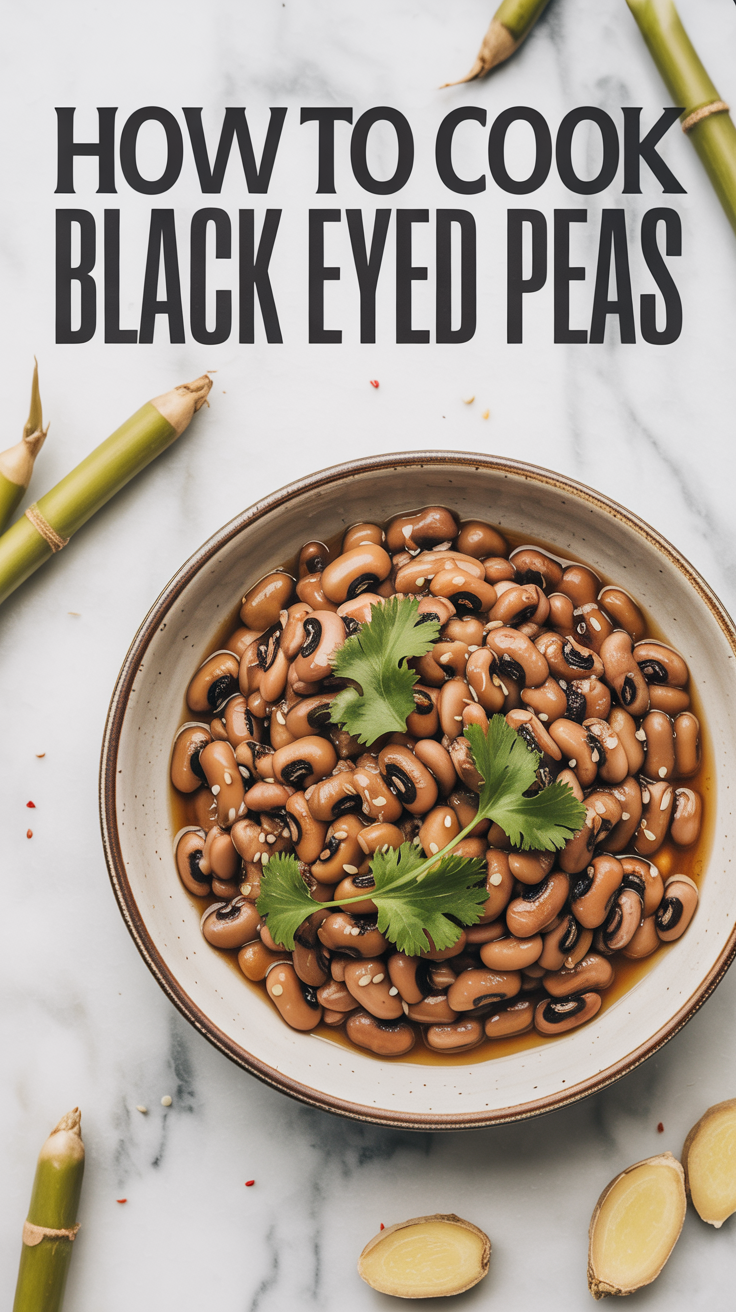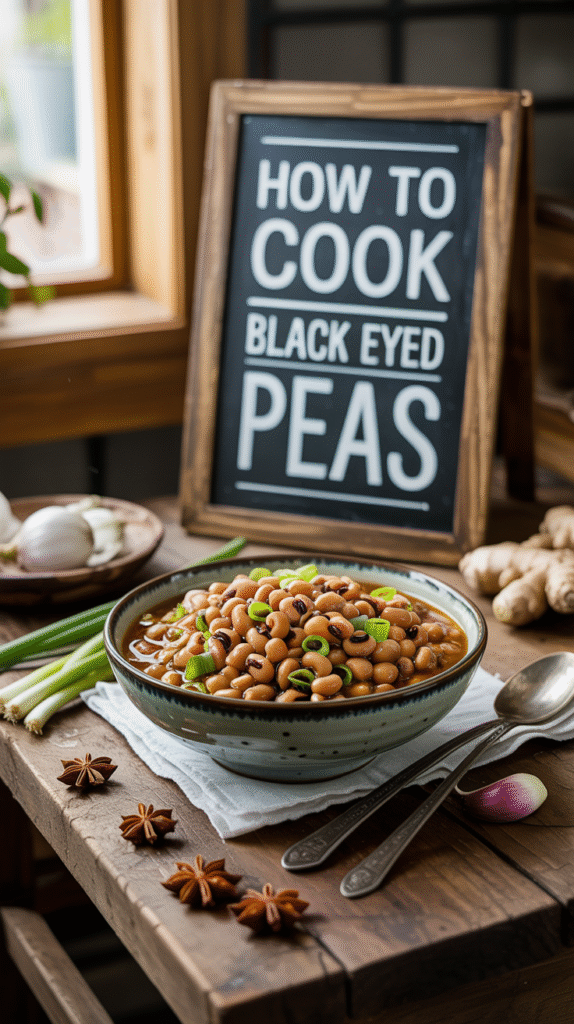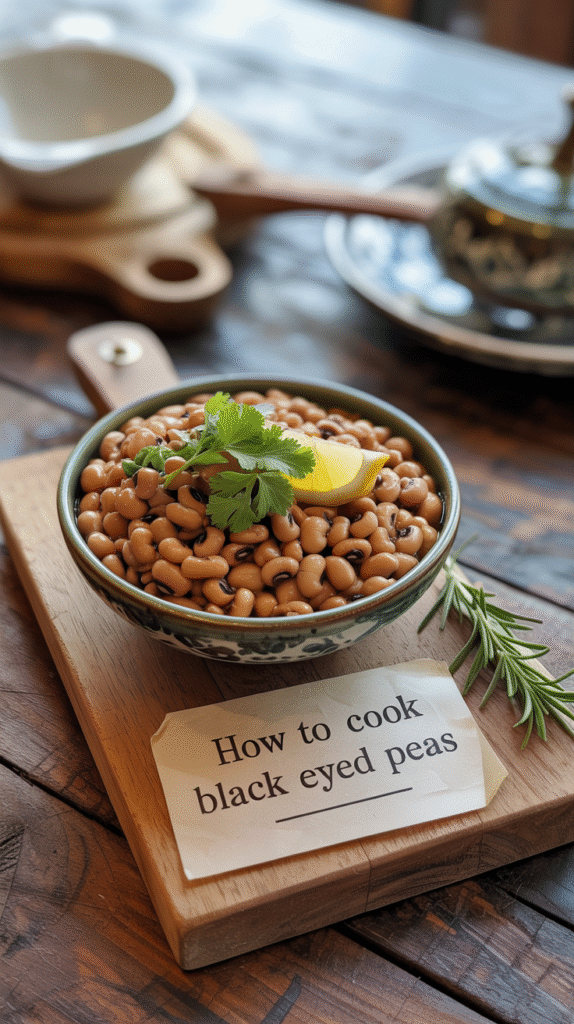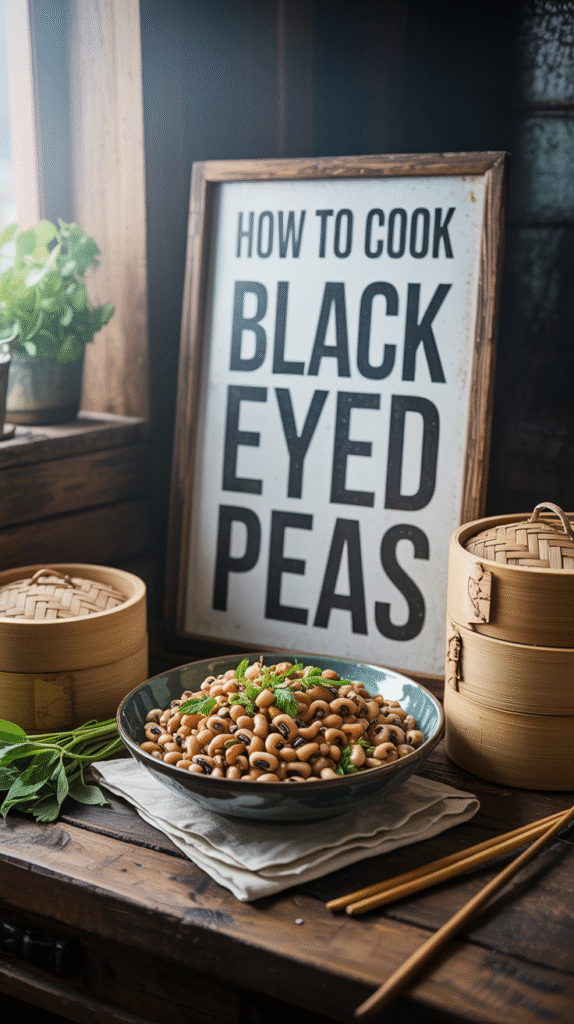Black eyed peas are a nutritious and versatile legume popular in many cuisines, especially in Southern cooking. They are rich in protein, fiber, and essential vitamins, making them a wonderful addition to your meals. If you’re wondering how to cook black eyed peas, this guide will provide various techniques and tips to achieve delicious results.
Preparing Black Eyed Peas
Before cooking black eyed peas, you need to prepare them properly. Here are the steps to follow:
- Sort and Rinse: Begin by sorting through the black eyed peas to remove any debris or damaged beans. Rinse them under cold running water to cleanse them thoroughly.
- Soaking (Optional): Soaking is not necessary for black eyed peas, but it can reduce cooking time. If you choose to soak, cover the peas with water and let them sit for at least 4 hours or overnight for best results.
Cooking Techniques
There are several ways to cook black eyed peas, allowing you to choose one that best fits your schedule and equipment.
1. Boiling on the Stove
Boiling is a simple method to cook black eyed peas. Here’s how:
- Pour the rinsed peas into a large pot and cover them with water. Use about three cups of water for every cup of peas.
- Add seasonings such as salt, pepper, or bay leaves if desired.
- Bring the water to a boil, then reduce the heat to low.
- Cover the pot and simmer for 30 to 45 minutes, or until the peas are tender. Stir occasionally and check the water level; add more water if necessary.
2. Using a Slow Cooker
A slow cooker is perfect for busy days. Try this method:
- Add the rinsed black eyed peas to your slow cooker.
- Pour in enough broth or water to cover the peas about an inch deep.
- Add your choice of seasonings.
- Cook on low for 6 to 8 hours or on high for 3 to 4 hours, until the peas are tender.
3. Instant Pot Method
This quick and efficient method works well for those in a hurry:
- Place the rinsed black eyed peas in the Instant Pot.
- Add three cups of water or broth for every cup of peas and seasonings as you like.
- Seal the lid, set the valve to the sealing position, and cook on high pressure for 10 to 12 minutes.
- Let the pressure release naturally for 10 minutes, then carefully release any remaining pressure.
Flavoring Your Black Eyed Peas
Enhancing the flavor of black eyed peas can turn a simple dish into a savory delight. Consider the following seasonings and ingredients:
| Flavoring Options | Description |
|---|---|
| Sautéed Onions and Garlic | Add these for a fragrant and flavorful base. |
| Smoked Ham Hock or Bacon | Incorporate for a delicious smoky flavor. |
| Spices (Cumin, Paprika) | Enhance with spices to give depth and warmth. |
| Fresh Herbs (Thyme, Parsley) | Add herbs at the end of cooking for freshness. |
Serving Suggestions
Black eyed peas are great on their own, but they can also complement many dishes. Here are some serving ideas:
- Serve as a side dish with cornbread or biscuits.
- Mix them into salads for added protein and flavor.
- Use them in soups or stews for heartiness.
- Make a black eyed pea dip with avocado, tomatoes, and spices for a healthy appetizer.
For more information on black eyed peas and recipes, visit Kitchen Society or check out Food Network for creative ideas.
Cooking black eyed peas can be simple and enjoyable. By following these techniques and tips, you’ll create delicious meals that everyone will love. Experiment with flavors and serving ideas to make this nutritious legume a favorite in your kitchen!
Nutritional Benefits of Black Eyed Peas
Black-eyed peas, a staple in Southern cooking, are not only tasty but also packed with nutrients. These legumes are a great source of fiber, protein, and essential vitamins. Let’s delve into the benefits you can gain from including black-eyed peas in your diet.
Rich in Nutrients
Black-eyed peas are loaded with essential nutrients that contribute to overall health. Here’s a closer look at some of the key nutritional components:
- Protein: A great source of plant-based protein, black-eyed peas contain about 13 grams of protein per 1-cup serving, making them an excellent option for vegetarians and vegans.
- Fiber: With approximately 9 grams of dietary fiber per cup, they assist in digestion and help maintain a healthy gut.
- Vitamins and Minerals: They are rich in vitamins A, C, and several B vitamins, including folate and thiamin. Black-eyed peas also provide important minerals like iron, magnesium, and potassium.
Health Benefits
The nutritional profile of black-eyed peas offers numerous health benefits, making them a smart addition to your meals:
1. Supports Digestive Health
The high fiber content in black-eyed peas plays a significant role in promoting gut health. Fiber helps regulate bowel movements, prevents constipation, and supports the growth of beneficial gut bacteria.
2. Aids Weight Management
Including black-eyed peas in your meals can help you feel full longer due to their fiber and protein content. This increased satiety can assist in managing your weight by reducing overall calorie intake.
3. Regulates Blood Sugar Levels
With a low glycemic index, black-eyed peas have been shown to help stabilize blood sugar levels. Their fiber content also slows down the absorption of sugar, making them a good choice for people with diabetes or those looking to maintain balanced blood sugar.
4. Boosts Heart Health
Black-eyed peas are known to improve heart health. They can help lower cholesterol levels due to their soluble fiber content. Additionally, the potassium found in these peas supports healthy blood pressure levels.
Easy to Prepare
Not only are black-eyed peas nutritious, but they are also simple to cook. Here are a few easy preparation methods:
- Boiling: Soak dried black-eyed peas overnight, then boil them in fresh water until tender.
- Canning: Canned black-eyed peas are a quick option; just rinse and heat them before adding to your dish.
- Stir-frying: You can add cooked peas to vegetable stir-fry for a nutritious boost.
Black-Eyed Peas into Your Diet
There are endless ways to enjoy black-eyed peas. Here are a few recipe ideas:
- Black-eyed pea salad with diced vegetables and a light vinaigrette.
- Hoppin’ John: A traditional Southern dish made with rice, black-eyed peas, and spices.
- Soups and stews that include black-eyed peas for added texture and nutrition.
When it comes to nutritious foods, black-eyed peas stand out for their many health benefits. With their rich nutrient profile and versatility in cooking, they are a valuable addition to any diet. Consider trying out different recipes and adding these legumes to your meals often.
For more information about the nutritional benefits of black-eyed peas, you can visit Healthline and Medical News Today.
Traditional Recipes Featuring Black Eyed Peas
Black-eyed peas are not just delicious; they also hold a special place in tradition, especially in Southern cuisine. With a rich history and numerous health benefits, black-eyed peas are celebrated in various traditional recipes. Here are some well-loved recipes that you can create to enjoy this versatile legume.
Hoppin’ John
This classic dish from the southern United States combines black-eyed peas, rice, and pork. Traditionally eaten on New Year’s Day, it’s believed to bring good luck for the year ahead.
- Ingredients: Black-eyed peas, white rice, diced ham or bacon, onion, and seasoning.
- Preparation: Cook the bacon until crisp, sauté onions, add black-eyed peas, and then mix in cooked rice. Simmer for flavor.
For a recipe that guides you through this traditional preparation, check out My Recipes.
Black-Eyed Pea Salad
This refreshing dish is light, healthy, and great for summer gatherings. A colorful combination of vegetables elevates the humble black-eyed pea.
- Ingredients: Black-eyed peas, diced cucumbers, tomatoes, red onion, bell pepper, and a dressing of your choice.
- Preparation: Combine all ingredients in a bowl, drizzle with dressing, and toss gently. Chill before serving.
This salad is a fantastic side dish for grilled meats. For a complete guide, visit Love and Lemons.
Southern-Style Black-Eyed Peas
If you enjoy comfort food, these slow-cooked black-eyed peas are a must. They’re flavored with spices that deliver a warm, savory taste.
- Soak black-eyed peas overnight or use the quick soak method.
- In a pot, sauté chopped onions, garlic, and peppers.
- Add soaked peas, vegetable or chicken broth, and seasonings like thyme and cayenne pepper.
- Simmer for about an hour until tender.
To make this dish even heartier, you could add smoked turkey or sausage. Interested in more details? Check out Food Network.
Black-Eyed Pea Soup
This hearty soup offers a warming meal perfect for winter nights. Packed with vegetables and spices, it satiates while being nutritious.
- Ingredients: Black-eyed peas, carrots, celery, onion, garlic, tomatoes, and vegetable stock.
- Preparation: Sauté vegetables, add black-eyed peas and stock, and let simmer. Blend for a creamier texture.
For an informative recipe, you can refer to Simply Recipes.
Veggie Stir-Fry with Black-Eyed Peas
This dish is perfect for a quick weeknight dinner, combining black-eyed peas with a variety of colorful vegetables.
- Ingredients: Black-eyed peas, bell peppers, broccoli, soy sauce, ginger, and garlic.
- Preparation: Stir-fry the veggies and add cooked black-eyed peas for a nutrition-packed meal.
You can find a more detailed recipe at AllRecipes.
These traditional recipes celebrate the unique flavor and healthy benefits of black-eyed peas. Whether you’re trying a comforting dish like Hoppin’ John or a refreshing black-eyed pea salad, you’re sure to enjoy these delicious options. Use them to create memorable meals that connect you to cultural traditions while delighting your taste buds!
Flavor Pairings and Seasonings for Black Eyed Peas
Black-eyed peas are not only delicious but also versatile, making them a wonderful choice for a variety of dishes. They can easily soak up flavors, making it essential to choose the right seasonings and flavor pairings to enhance their natural taste. Here’s how to season black-eyed peas and some complementary ingredients that can elevate your dish.
Essential Seasonings for Black-Eyed Peas
To cook black-eyed peas and make them burst with flavor, consider these essential seasonings:
- Salt: A must for enhancing flavor, add salt toward the end of cooking to prevent the peas from becoming tough.
- Pepper: Freshly cracked black pepper adds a mild heat that balances the peas’ earthiness.
- Garlic: Minced or powdered garlic gives an aromatic depth to your dish.
- Onion: Sautéed onions add sweetness; try using yellow or red onions for a milder flavor.
- Thyme: Fresh or dried thyme adds a lovely herbal note.
- Bay Leaves: A couple of bay leaves in the cooking water can impart a subtle depth of flavor.
- Smoked Paprika: This adds a smoky dimension, perfect for soul food dishes.
Flavor Pairings that Shine with Black-Eyed Peas
Black-eyed peas pair well with a variety of ingredients, allowing you to create diverse meals. Here’s a list of some fantastic flavor pairings:
| Flavor Pairing | Complementary Taste |
|---|---|
| Bacon or Ham Hocks | Smoking and savory richness |
| Tomatoes | Freshness and acidity |
| Greens (Collard, Spinach) | Earthy and slightly bitter |
| Hot Peppers | Spice and heat |
| Carrots | Natural sweetness |
| Lemon or Lime Juice | Bright acidity |
| Cumin | Warm and earthy |
Cooking Techniques for Maximum Flavor
Choosing the right cooking technique can greatly enhance the flavors of black-eyed peas:
- Soaking: Soak dried black-eyed peas overnight to reduce cooking time and improve digestibility.
- Slow Cooking: A slow cooker allows the flavors to meld beautifully. Combine your peas with bacon, onions, garlic, and seasonings for an aromatic dish.
- Simmering: Cook the peas on low heat in broth with spices. This allows the flavors to infuse deeply.
Regional Influences on Seasoning
Different cultures lend their unique spices and techniques to black-eyed peas, leading to flavorful variation:
- Southern Cuisine: Often includes smoked meats, hot sauce, and collard greens.
- Caribbean Cuisine: Incorporates coconut milk and spices like allspice or nutmeg.
- Indian Cuisine: Might feature curry spices like turmeric, cumin, and coriander for a spicy kick.
For tips on using black-eyed peas in various dishes, from soups to salads, check out resources such as Love and Lemons and Simply Recipes.
These seasonings and flavor pairings will ensure your black-eyed peas are both flavorful and satisfying. Whether you’re cooking a traditional Southern meal or experimenting with global cuisines, the right spices can elevate your dish to new heights.
Common Mistakes to Avoid When Cooking Black Eyed Peas
Cooking black-eyed peas can be a delightful experience, but many encounter common pitfalls that can ruin this nutritious dish. Understanding these mistakes can ensure that you get the most flavor and freshness from this versatile legume. Here are some pitfalls to avoid when cooking black-eyed peas.
Overlooking the Importance of Soaking
One of the most common mistakes people make is not soaking black-eyed peas before cooking. Soaking helps to soften the beans, making them cook more evenly and reducing cooking time. Ideally, you should soak them for at least 4 hours or overnight. If you’re pressed for time, a quick soak method—boiling the peas for 2–3 minutes and then letting them sit for 1 hour before cooking—can work just as well.
Using Insufficient Water
Using too little water is another frequent error. Black-eyed peas absorb a lot of water while cooking, which is necessary for them to soften and release their delicious flavor. When simmering, make sure to cover your peas with about 2 inches of water above their surface. Adding more water as needed will prevent them from drying out and burning.
Neglecting Flavoring Agents
Cooking black-eyed peas in plain water can lead to bland results. Adding flavoring agents can elevate the dish significantly. Consider using:
- Vegetable or chicken broth instead of water.
- A bay leaf, thyme, or rosemary for aromatic flavor.
- Onions, garlic, or peppers to deepen the taste profile.
Not Accounting for Cooking Time
Another mistake to avoid is cooking black-eyed peas for too short or too long. Cooking them inadequately will leave them hard and crunchy, while overcooking can turn them mushy. Generally, they take about 30 to 40 minutes on the stovetop after soaking. For dried but unsoaked peas, you might need about 1 to 1.5 hours. Always check for tenderness and adjust cooking times according to your preference.
Forgetting to Season After Cooking
It’s important to remember that seasoning should not only be done at the start of cooking. After the black-eyed peas are done, taste and adjust the seasoning. This is when you can add salt, pepper, or additional spices to make the final dish pop. Keep in mind that adding salt early can also inhibit the cooking process, making the peas tougher.
Ignoring the Nutritional Benefits
While you may be focusing on flavor, don’t overlook the nutritional benefits of black-eyed peas. They are rich in protein, fiber, and essential vitamins and minerals. Instead of heavy creams and oils, try to pair them with fresh ingredients like carrots, tomatoes, or spinach to amplify both health benefits and taste. For a guid to cooking black eyed peas, visit Food Network.
Failing to Store Properly
After cooking, proper storage is crucial to maintain the flavor and freshness of your black-eyed peas. Leaving them out at room temperature for more than two hours can lead to spoilage. Instead, store them in a sealed container in the refrigerator and consume within 3–5 days. If you have leftovers, you can freeze them for up to six months.
Using Raw Beans
One mistake to avoid entirely is cooking raw black-eyed peas without processing them first. Dried peas often require a bit of preparation, such as rinsing or soaking. Make sure to check the packaging instructions for guidance on preparation methods.
Not Experimenting
One of the common mistakes is failing to experiment with different recipes and cooking styles. Black-eyed peas are incredibly versatile. They can be used in soups, salads, stews, or even as a side dish. Do not hesitate to explore various cuisines that incorporate black-eyed peas to discover new flavors.
Besides being delicious, black-eyed peas are culturally significant, especially in Southern cuisine. They are traditionally eaten on New Year’s Day for good luck, purportedly symbolizing prosperity. Embracing this cooking tradition while avoiding common mistakes will surely lead to delicious results on your plate!
For more tips on cooking legumes, check out Cooking Light.
Conclusion
Cooking black-eyed peas can be a rewarding and flavorful experience that brings both nutrition and culture to your table. By mastering key techniques and tips, you can elevate this humble legume into a delightful dish that shines at any meal. Embracing the nutritional benefits of black-eyed peas, rich in protein and fiber, can enhance your diet and promote overall wellness.
When exploring traditional recipes, you honor the heritage of this ingredient, finding joy in dishes that have been passed down through generations. Pairing black-eyed peas with the right flavors and seasonings, such as smoked meats, garlic, or fresh herbs, creates heartwarming meals that are as satisfying as they are delicious.
Be mindful of common mistakes, like undercooking or neglecting to soak your peas, which can lead to less than desirable results. Taking the time to prepare them properly ensures a creamy texture and rich flavor that can elevate your recipes.
Ultimately, cooking black-eyed peas is not only about the steps you take in the kitchen but also about embracing the stories and traditions that accompany them. Whether you’re enjoying them in a classic Southern dish or experimenting with new flavor profiles, black-eyed peas are versatile and welcoming, ready to be a part of your culinary adventures. So, gather your ingredients, follow the tips, and let the delightful experience of cooking black-eyed peas enrich your meals and your life.







Leave a Reply